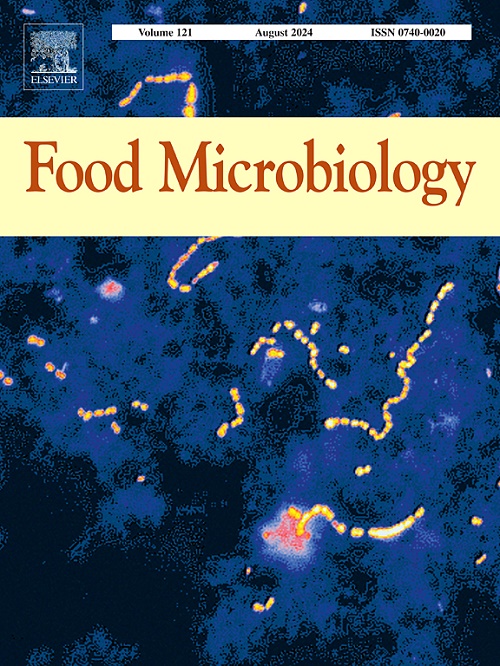中国发酵玉米中克罗诺杆菌的发生、分子特征和耐受性
IF 4.5
1区 农林科学
Q1 BIOTECHNOLOGY & APPLIED MICROBIOLOGY
引用次数: 0
摘要
克罗诺杆菌是一种机会致病菌,可在所有年龄组引起严重感染。这种生物经常从植物性食物中分离出来,尤其是谷物。因此,本研究确定了克罗诺杆菌在中国发酵玉米制品(FCP)中的发生、分子特征和耐受性。根据多位点序列分型(MLST)(包括致病相关等位基因ompA)和血清分型对分离株进行了物种和基因分型。从发酵玉米面条、发酵玉米面团、发酵玉米粉丝、发酵玉米面糊、发酵玉米饮料和发酵玉米面包等216份FCP样品中分离到22株克罗诺杆菌(20株阪崎克罗诺杆菌和2株麦氏克罗诺杆菌)。所有克罗诺杆菌分离株分为8个序列型(STs)、4个血清型和4个ompA基因型。优势型(10/22)为阪崎弧菌ST8型、阪崎弧菌O:2型和ompA5型,主要分布在发酵玉米面和发酵面团中。在所有菌株中,含有ST770的克罗诺杆菌菌株对酸、渗透胁迫和寒冷的耐受性较强,而含有ST8的克罗诺杆菌菌株对酸、渗透胁迫和寒冷的耐受性较弱。8株菌株表现出较强的生物膜形成能力(OD595 >;1),其中ST770、ST771和ST556菌株表现出较明显的能力。所有克罗诺杆菌对阿莫西林/克拉维酸、头孢他啶、氨曲南、美罗培南、四环素、环丙沙星、甲氧苄啶/磺胺甲恶唑、多粘菌素B和氯霉素敏感,对头孢噻肟耐药的占77.27%。本研究支持了克罗诺杆菌通过植物性食物传播的担忧,并为该病原体在FCP中的预防和控制提供了理论依据。本文章由计算机程序翻译,如有差异,请以英文原文为准。

Occurrence, molecular characterization and tolerance of Cronobacter spp. isolated from fermented corn products in China
Cronobacter spp. is an opportunistic pathogen that cause serious infections in all age groups. The organism has frequently been isolated from plant-based foods, especially cereals. Therefore, this study determined the occurrence, molecular characterization and tolerance of Cronobacter in fermented corn products (FCP) in China. Isolates were speciated and genotyped according to multilocus sequence typing (MLST), which included the pathogenicity associated allele ompA, as well as serotyping. Twenty-two strains of Cronobacter (20 C. sakazakii and 2 C. muytjensii) were isolated from 216 FCP samples, such as fermented corn noodles, fermented corn doughs, fermented corn vermicelli, fermented corn flour paste, fermented corn beverage, and fermented corn bread. All Cronobacter isolates were divided into 8 sequence types (STs), 4 serotypes and 4 ompA genotypes. The dominant type (10/22) was C. sakzakii ST8, C. sakazakii serotypes O:2, and ompA5, mainly in fermented corn noodle and fermented corn dough. Of all the strains, Cronobacter strains with ST770 had a stronger ability to tolerate acid, osmotic stress and cold, while Cronobacter strains with ST8 had a weaker tolerance to acid, osmotic stress and cold. Eight isolates exhibited strong biofilm-forming ability (OD595 > 1), among which the ST770, ST771, and ST556 strains showed more pronounced abilities. All Cronobacter isolates were sensitive to amoxicillin/clavulanic acid, ceftazidime, aztreonam, meropenem, tetracycline, ciprofloxacin, trimethoprim/sulfamethoxazole, polymyxin B, and chloramphenicol, while 77.27% of isolates were resistant to cefotaxime. This study supports the concern of Cronobacter transmission through plant-based foods, and provides a theoretical basis for the prevention and control of this pathogen in FCP.
求助全文
通过发布文献求助,成功后即可免费获取论文全文。
去求助
来源期刊

Food microbiology
工程技术-生物工程与应用微生物
CiteScore
11.30
自引率
3.80%
发文量
179
审稿时长
44 days
期刊介绍:
Food Microbiology publishes original research articles, short communications, review papers, letters, news items and book reviews dealing with all aspects of the microbiology of foods. The editors aim to publish manuscripts of the highest quality which are both relevant and applicable to the broad field covered by the journal. Studies must be novel, have a clear connection to food microbiology, and be of general interest to the international community of food microbiologists. The editors make every effort to ensure rapid and fair reviews, resulting in timely publication of accepted manuscripts.
 求助内容:
求助内容: 应助结果提醒方式:
应助结果提醒方式:


